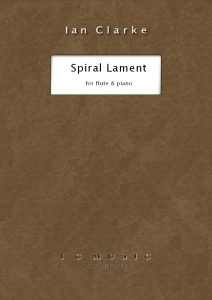Spiral Lament

Spiral Lament – (flute & piano) [closed and open-hole fingering options – Cft or Bft – intermediate or advanced]
Also available the 3 pieces compilation book with Spiral Lament and The Mad Hatter.
It uses techniques unfamiliar to both the intermediate and advanced player providing
an approachable and achievable challenge for both. There are exercises to give a simple approach to the attractive and exotic world of quarter-note grace notes featured in the piece. First published in 2004. Commissioned by Hannah Money.
Early performances in headline recitals in 2004 British Flute Society’s International Convention and the 2005 National Flute Association’s convention. It has been regularly performed since then. Spiral Lament was performed as part of the winning recital programme of BBC Young Musician winner Emma Halnan in 2010. It is listed on the AMEB (Australian Examinations Board).
Notes from printed edition of music:
Hannah Money asked me several years ago to compose a piece for her giant African Snails! I have to admit to being not a little perplexed. Sometime later I met one of these incredible creatures and had a long close look……an unforgettable moment! It was like looking through a window into a strange and wondrous alien world. For me, this experience made more potent the wonder of the natural world we live in. I also have young children who constantly marvel and delight in creatures of all sorts. They often overcome initial feelings of fear in order to pick up and befriend something to which an adult may not give a second thought – the occasional snail gets the better of their curiosity and is taken under their wing. Grown-ups are frequently forced to give the world of small animals, with strange and varied methods of locomotion, a second thought. Beyond fear there is fascination, discovery and a different space.
I found all this rather exotic, inspiring and quite profound. This was now something I wanted to express. Hannah had asked that I make the piece playable and approachable for an intermediate, not just an advanced player. In the end I have used techniques unfamiliar to both intermediate and advanced flautists so I hope it will be an achievable and fun challenge for all.
In order to remove some of the apprehension about these unfamiliar techniques I have set out some exercises that will give you a plan of attack should you need one. I think I can safely say that they are not poisonous or harmful …… although you may dream quarter-tones for a few days, they have no teeth or slimy bits!
The piece can be interpreted on a number of different levels. The descriptive element is hopefully self-evident and fun to explore but perhaps more importantly, some sense of the marvel of living things and hence connection with our own existence is also present!
Finally, I would like to say a huge thank you to my wife and Hannah for their enthusiasm and encouragement.
Ian Clarke
August 2003
Further notes:
The following has been compiled from some of the email conversations with respect to dissertations and programme notes on Spiral Lament.
Email question:
Did you learn about quarter tones and special effects or did you create them
yourself?
“I learnt about the special effects from various sources who in turn learnt much of what they know from other sources. There are moments where I may have pushed the boundaries. My use of them is perhaps individual and I am more interested in the ends rather than the means. Knowledge is often more of a continuum than it may first may appear. There are of course exceptions to this. With respect to the quarter-tones I think the solo piece ‘Mei’ by Fukushima is probably the first flute piece I remember coming across that explicitly used them; in themselves they are rather more ancient and occur in all sorts of non ‘European classical’ scales. I was greatly influenced by a solo piece called ‘Xi’ by Stockhausen which consists almost entirely of quarter-tone and micro-tone scales; this is a little known piece partly because of its difficulty but one that certainly pushes the western flute into new territory …. again unaccompanied …. it doesn’t however use any of the 1/4 tone grace note idea in Spiral Lament – this use is unlike any other piece I can think of whilst seeming to be a completely natural inflected decoration. The idea of substituting fingers to get different colours originally came from Robert Dick’s ‘Tone Development Through Extended Techniques’ which is book I recommend you get. He is a very influential American flute player-composer who has done a great deal to disseminate ideas about extended techniques on the flute.”
Ian
Email enquiry:
………My main interest was the phrase you used in your introduction “Beyond fear there is fascination, discovery and a different space”
“This is partly a metaphor for the performer approaching a piece like this for the first time i.e. in reference to its expanded technical language. It is also an encouragement to discover something beyond the seemingly superficial descriptive layer of the music and view the world from a new philosophical and emotional snail’s perspective …. presumably snails aren’t afraid of themselves and this hypothetical view point could be extended to many small creatures. As a flautist this gives scope for subtleties of connections, shadings and colourings in the opening for example which is initiated by the other colours explicitly given to the opening notes”
Ian